
46 minute read
The Origami Telescope
FAILURE NOT AN OPTION
All things considered, Webb had a smooth launch. So smooth that McCaughrean even described it as ‘completely perfect’. When planning a mission as bold as this, scientists allow for a window of possible error that may tweak a trajectory but still give the result you want. Webb, however, followed a path that simulations would have described as flawless. So far, so good. Next came the deployment of the sunshield and unfolding the telescope. For those scientists who had spent decades on this mission, this is where the nail-biting began. Think about it. You have a 6.5m (21ft) dish that is made up of eighteen individual mirrors. Each of those has pins to release mechanisms – the primary mirror itself has 178 release mechanisms alone, plus additional latches to keep things in place. In fact, JWST had 344 ‘single points of failure’ – consider them breaking points – when it left Earth. All it needed was for one of those to kick off and it was mission over. The first step to unfolding the biggest telescope ever made began thirty-three minutes after launch with the release of Webb’s solar array, to enable it to generate its own power. Fortunately, the manoeuvre went smoothly. A day later, the communication antenna sprang into action. After these two automatic processes, everything else was controlled by the team on the ground. All eyes were on Webb.
Advertisement
Two days after launch, the observatory still looked like a bud waiting to bloom. The primary dish was curled up, enveloped by two structures carrying the sunshield. But by day three the sunshield started to peel away, beginning its long-awaited deployment phase. Two long, rectangular planks – officially called the Unitized Pallet Structures (UPS) – carrying the folded-up sunshield membranes, unfurled at the front and back. A day later, the now-exposed telescope rose by 1.22m (4ft) to distance the telescope from the spacecraft – firstly, to create room for the sunshield to stretch out when the time came; and, secondly, so that the telescope could begin its cooling process. Six days after launch and JWST’s sunshield now started to resemble the famous kite structure we had been promised. With every completed step, the likelihood of having a new space telescope was increasing. A few days into the New Year and the two-day activity of tensioning the sunshield began. Three of the five layers were pulled into place, and by the following day all five layers were fully tensioned. One enormous parasol had been deployed. After decades of delays and increasing costs, this was the first proof that Webb was worth it.
If you have lost track of the days, we are now at day eleven. But that period after Christmas is always hazy. Now it’s the telescope’s time to shine. From an upright position, secured by long metal arms (aka booms), the secondary mirror swings in front of the twelve central mirrors. This smaller mirror is responsible for reflecting everything the mammoth main dish collects to beam it to the instruments on board. Finally, the wings of the primary mirror unfurl. Right goes first and it’s a success. Left wing follows … and exactly two weeks after launch, the observatory is in place.
Webb assumes the position of the most impressive space telescope ever made.
If space wasn’t a vacuum, it probably could have heard the cheers from ground control. Webb arrived at its destination on 24 January 2022. Lagrange Point 2 (L2) is located 1.5 million kilometres (932,000 miles) from our blue dot. It is a fortuitous region, in the exact opposite direction from the sun, where the gravity from the Earth and our star balances the orbital motion of a satellite. Parking Webb here gives it a fixed position relative to the two bodies. Being quite literally a million miles from Earth is also an ideal spot to radiate heat out into deep space. Hunting for those earliest galaxies is no easy job. They are old. And that means their infrared (heat) signals are faint. The last thing Webb needs is our local fireball, with its light and heat, throwing it off the trail. The fact that the telescope is plunged into twenty-four-hour darkness at temperatures just above absolute zero gives it the best chance possible. So how does the James Webb Space Telescope actually work?
DUSTY VEIL
‘We always start off with talking about the Hubble Space Telescope,’ Keith Parrish, Observatory Commissioning Manager for the James Webb Space Telescope, told the Supermassive Podcast. I know you are here to read about Webb but bear with.
‘Hubble is just fantastic,’ continued Parrish. ‘One of the most ground-breaking things that Hubble has taught us is that the amount of galaxies in our universe is mind-boggling.’
Launched on 24 April 1990, the Hubble Space Telescope (HST) delivers 140 gigabytes of science data back to Earth every week and has transformed our view and knowledge of the universe. ‘[In] every direction that you would look, Hubble’s actually able to spy some of these early galaxies,’ said Parrish. ‘They just look like little red dots. Nobody knows how they’re constructed.’
ABOVE: Hubble in 2000. Note the two spacewalking astronauts in front of it for a sense of scale. NASA/ESA LEFT: The giant nebula NGC 2014 and its neighbour, as photographed by Hubble in 2020. NASA/ESA/STScl

Hubble has shown us so much more than these captivating little red dots. It has revealed the size and age of the universe, the birth and death of stars, formation of galaxies and storms on Saturn and Jupiter. It has been used to investigate dark matter and probe the atmospheres of alien worlds. And alongside these leaps of knowledge, it has left a huge cultural legacy.
Hubble itself isn’t exactly small. NASA describes it as being the size of a large school bus, and having the weight of two adult elephants (if you are inclined to measure things in elephants). For the stargazing fans, it’s an epic Cassegrain telescope design. For everyone else, it’s tube-like in shape.
What sets Hubble apart from telescopes here on Earth is that it sits above our atmosphere, the very definition of a ‘space’ telescope. At just 547km (340 miles) above Earth, Hubble can observe objects that would be impossible to see from the ground. Although the telescope does have some infrared capabilities, it mostly studies the universe at optical and ultraviolet wavelengths, connecting us to its infinite vastness. But JWST will send us further.
Let me take you back to those ‘little red dots’ that Keith described. Hubble can capture some of those infrared signals,


ABOVE: Jets of energised gas ejected from a young star. ESA/Hubble & NASA, D. Padgett (GSFC), T. Megeath (University of Toledo), and B. Reipurth (University of Hawaii) OPPOSITE: The star cluster Pismis 24. NASA, ESA and Jesús Maíz Apellániz (Instituto de Astrofísica de Andalucía, Spain)
Electromagnetic Spectrum telescope comparison. NASA and J. Olmstead (STScI)

as long as the light they emit sits somewhere between 0.8 and 2.5 microns on the spectrum of light. But what it cannot tell us is what is hiding behind the clouds of gas and dust that may surround them. These hidden realms are where planets and stars form. And they absorb visible light. Hubble cannot penetrate them. Webb, an infrared telescope, will carry on Hubble’s legacy and cut through that dusty veil.
Parrish was understandably very excited about the new telescope’s capabilities. ‘[We’re] going from that very first thing: how did stars and galaxies come about?’
Webb can, hopefully, answer that question by studying their light. The older the star, the further away it is, and, therefore, the more ‘stretched’ or ‘red-shifted’ its light becomes. Essentially, their signal is pushed from UV and optical wavelengths into the near-infrared as it travels away from us.
‘Then we can go down another level. How do planets form?’ said Parrish. ‘I always say George Lucas had it right in Star Wars. He knew that there were lots of planets out there. Almost every star you look at in the sky probably has a planet around it, and that’s really, really cool.’
We already know that Tatooine-like systems exist, with planets circling two stars. But let’s not forget, at the time of Hubble’s launch, we did not even know that there were other planets beyond our solar system.
Parrish’s list of potential JWST benefits continued to grow. ‘And more importantly, how do planets with all the conditions that we would expect to support life form? To think that we have built a telescope that’s a hundred times more sensitive than Hubble. I mean, it’s hard for me to get my head around and I work on it every day.’
KITCHEN FOIL
To explore these new horizons, Webb needs its sunshield, telescope and instruments to work in unison, operating at ‘beyond-frostbite’ temperatures to transport us to the depths of the unexplored universe. It’s going to be dark, cold and big. Aerospace company Northrop Grumman has put materials science to the test to start that journey.
Take the iconic sunshield, for example. Its tennis court-sized parasol is made from a wonder lightweight material called Kapton, with a coating of aluminium for that kitchen-foil glimmer. Across five layers, temperatures start at 383K (110°C/230°F) on the sun-facing side and drop down to a chilly 36K (-237°C/-394°F) on the cold side.
The thing I struggle to wrap my head around is just how drastically the temperature is reduced across five thin layers. As sunlight hits the first layer, a lot of it is radiated back into space with the added help of a doped-silicon coating. Some heat will get through but then the second layer blocks and redirects that away too. With each layer, heat continues to be dissipated. Layer one is just 0.05mm thick and the rest are 0.025mm. And if you are thinking about the coatings, well, they can be measured in nanometres.
BIG DISH
Then we have the primary mirror. The bigger the mirror, the more light it can collect, and the more detail it can see. The engineers designing Webb worked out that a diameter of 6.5m (21ft) would do the trick. They then just had to make it, jam it into a rocket and get it into space.
Cue second wonder material: beryllium. A third lighter than aluminium but six times stronger than steel, and with the ability to keep its shape when plunged into cryogenic temperatures, this beat other options hands down. The JWST sunshield. NASA/Chris Gunn
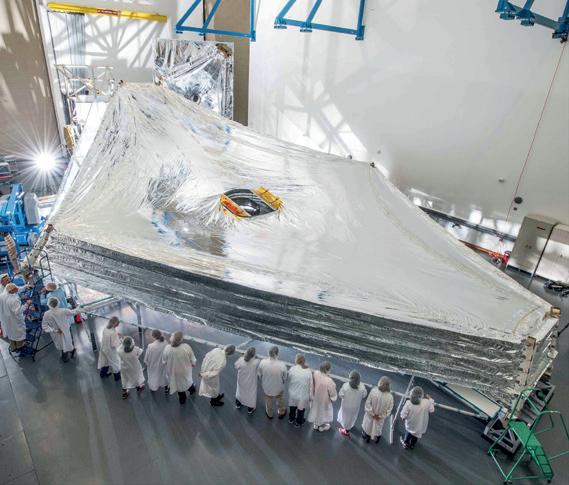
This audacious primary mirror consists of eighteen smaller hexagonal segments, each 1.32m (4.3ft) in diameter, which pack together like honeycomb. Going from raw material to shiny completed segments has taken fourteen stops to eleven places across America. Each mirror started its life as a hefty 250kg (550lb) hexagonal cast, or ‘blank’. But there is no way they could launch eighteen of those; the fuel cost would be ridiculous. The manufacturers were able to remove 92 per cent of that material by carefully cutting out intricate triangular patterns from the back, bringing it down to just 21kg (46lb). Next came the polishing and processing, to ensure each mirror was as close to perfectly smooth as possible – reaching accuracies of less than one millionth of an inch. The final touch to the design was a microscopically thin layer of gold. Why? To make it shiny. Or, in engineering terms, ‘to ensure the highest infrared light reflectivity to Webb’s instruments’. Silver sits at 95 per cent reflectivity, aluminium is about 85 per cent, whereas gold hits the jackpot at 99 per cent. It is also extremely unreactive. We cannot have the world’s largest and most powerful infrared observatory tarnishing in space, can we?

STAR HUNTER
Directly behind Webb’s primary dish is the Integrated Science Instrument Module (ISIM) which houses four key instruments. The telescope collects the light, which is beamed to all of them at the same time by the primary mirror, ready to pick apart the mysteries encoded within. First up, we have JWST’s primary imager, the Near-Infrared Camera (NIRCam), built by the University of Arizona. Consider it the galaxy and star hunter. Operating at wavelengths between 0.6 and 5 microns, it can detect light from the formation of the earliest stars and galaxies, as well as young stars in the Milky Way and Kuiper belt objects. To do so, it simultaneously scans two adjacent fields of view and observes them in both shorter and longer infrared wavelengths. It is also equipped with something called a ‘coronagraph’. This blocks starlight, allowing us to examine smaller, fainter objects nearby, like planets. It is not dissimilar to holding your hand to your head on a sunny day, allowing you to focus your view. Hopefully upon the ice-cream van that’s approaching in the distance. Then there’s the Near-Infrared Spectrograph, or NIRSpec. The chemist. NIRSpec will split the light from far-off stars into a spectrum to reveal the object’s physical properties. Just like a unique fingerprint, an object’s light can leave a pattern which is a signature of individual chemical elements, revealing what they’re made of, as well as temperature and mass. NIRSpec can observe 100 objects simultaneously thanks to 250,000 microshutters. These tiny windows with shutters, the width of a human hair, open and close when a magnetic field is applied and can be controlled individually. Never have scientists been able to analyse so many objects at precisely the same time. After that, there is the catchiest name yet … the Fine Guidance Sensor/Near-Infrared Imager and Slitless Spectrograph (FGS/ NIRISS), provided by the Canadian Space Agency. The guider. FGS will help point the telescope and its NIRISS component will be responsible for investigating the first light detection, exoplanets and their characteristics, as well as studying their spectroscopy as they move past their star, otherwise known as a transit. Finally, there is the Mid-Infrared Instrument (MIRI), made by a British team. The double whammy. ‘It is both a camera and a spectrometer. That makes it a little bit special,’ Gillian Wright, MIRI’s principal investigator, told us. ‘It’s really important because you break the light down into its constituent colours and every atom in the universe has a unique signature. In the mid-infrared where MIRI looks, it’s very sensitive to seeing interesting types of molecules like methane and water.’ While MIRI too will be working with the other instruments, looking at the first stars and exploring galaxies, there’s something
Engineers installing the MIRI into the Integrated Science Instrument Module, in the cleanroom at NASA’s Goddard Space Flight Center. NASA/Chris Gunn
that makes it unique. ‘[We’re] studying the structure in those disks and trying to understand which disks would have the potential to make what kinds of planets,’ said Wright. ‘And MIRI is very good at that. Because of its long wavelengths, we can peer much further into these dusty disks than you can with the other instruments.’ These long wavelengths are 5–28 microns, which is great for cutting through cold, dense and dusty regions that had previously been closed off to prying telescopes. Plus, if we want any hope of finding the oldest galaxies, it will be MIRI that will spot their distant, stretched (redshifted) light. Putting it into perspective, mid-infrared light is given off by objects at room temperature, so these signals are going to be faint. To ensure MIRI snaps them up, it comes with its own fridge, cooling the instrument to just 7K (-266°C/-447°F), keeping it clear of any background light.

FIRST LIGHT
People waited in anticipation for the first images from Webb. I would not be surprised if sweepstakes were running through the astronomical community. We had our own (hypothetical) money on Webb’s take on the Pillars of Creation, three towers of gas and dust in the Eagle Nebula made famous by Hubble in 1995. But before those first images appeared, NASA kept the telescope’s fans in the loop every step of the way. ‘They didn’t really intend to,’ says McCaughrean. I wondered if that was because NASA faced so much ridicule after Hubble launched. Initially, the $1.5 billion Hubble Space Telescope was a disaster. Most serious among a catalogue of flaws – including communications, component and electronic failures – was a fault with the primary mirror. Hubble became the butt of jokes across the world. Mark mentioned there were concerns regarding Webb’s earliest data. ‘If we show them not very good images, they’ll say it’s broken.’ I imagine NASA initially wanted to keep their cards close to their chest. But, internally, there was pushback. ‘Take them on the journey. Take them through the process. Eighteen mirrors. They’re not super-sharp. Now you align them and just have to tell the story.’ And thank goodness they did. Every calibration, every ‘rough’ image, was celebrated. One of the earliest alignment phases for Webb was from NIRCam. It produced an image of eighteen smudges; a single point interpretated by each individual mirror. By making tiny adjustments, as well as with the secondary mirror, those eighteen smudges transformed into eighteen clear points. With the segment alignment completed, the actuators – a series of small motors controlling the mirrors – moved each segment to overlap their light and work as one. The engineering to do this did not exist before Webb. We are talking seriously small movements here. Engineers moved the mirrors by 1/10,000th the thickness of a human hair. It’s still bonkers. By 16March 2022, we had our first colour image. ‘Following the completion of critical mirror alignment steps,’ stated NASA’s press release, ‘[the] James Webb Space Telescope team expects that Webb’s optical performance will be able to meet or exceed the science goals the observatory was built to achieve.’ This was the confirmation that Webb was going to deliver. Suddenly, this unspecific star that just happened to be the right brightness for calibration became one of my favourite images of space. And get used to seeing those eight shining beams emerging from a point; this is Webb’s signature look. The six large ones are the diffraction pattern from its hexagonal shape, with two smaller lines from Webb’s secondary mirror.
That favourite image, however, was blown out of the water on 12 July 2022. From the deepest view of the Universe to cosmic mountains and valleys full of twinkling stars, NASA released the first five images from JWST and our view – and understanding – of the universe was changed forever. The James Webb Space Telescope had given us a view into the unknown and it was everything I had hoped for. It was also just as McCaughrean had predicted. ‘We know the things that it’s designed to do, and we know they haven’t been touched for two decades because you just can’t get close to them without Webb,’ he says. ‘It’s all still there waiting but what else is there to find? Could it possibly be that there’s something completely different that we haven’t even thought of? I can’t tell you what they’ll be, but it’ll be amazing when they come up. ‘And with a machine this powerful, they will.’


ABOVE: The same star, as seen by the Spitzer Space Telescope (launched in 2003) and JWST. Left: G Brammer (University of Copenhagen); Right: NASA/STScl OPPOSITE: A new shot of the iconic Pillars of Creation image taken by Hubble in 2015. NASA, ESA/Hubble and the Hubble Heritage Team (STScI/AURA)
REVEALING THE WONDERS OF THE EARLY UNIVERSE
After the excitement of launch and successful deployment, the first pictures from the James Webb Space Telescope were always going to be special. Only a select few within the space community had any idea what these images would be. It was such a closely guarded secret, the rest of us could only speculate. When the day came, the pictures did not disappoint. US president Joe Biden unveiled the first image during a White House briefing on 11 July 2022. The next day, in a global broadcast, NASA and ESA released a further four images (including a graph showing the atmospheric composition of the exoplanet WASP 96b, not pictured here), giving a perspective that NASA administrator Bill Nelson described as ‘a view the world has never seen before’. Over the coming months, we can expect plenty more revelations from Webb, but these first images will always remain significant – proof that if we humans put our minds to something, we can do incredible things.
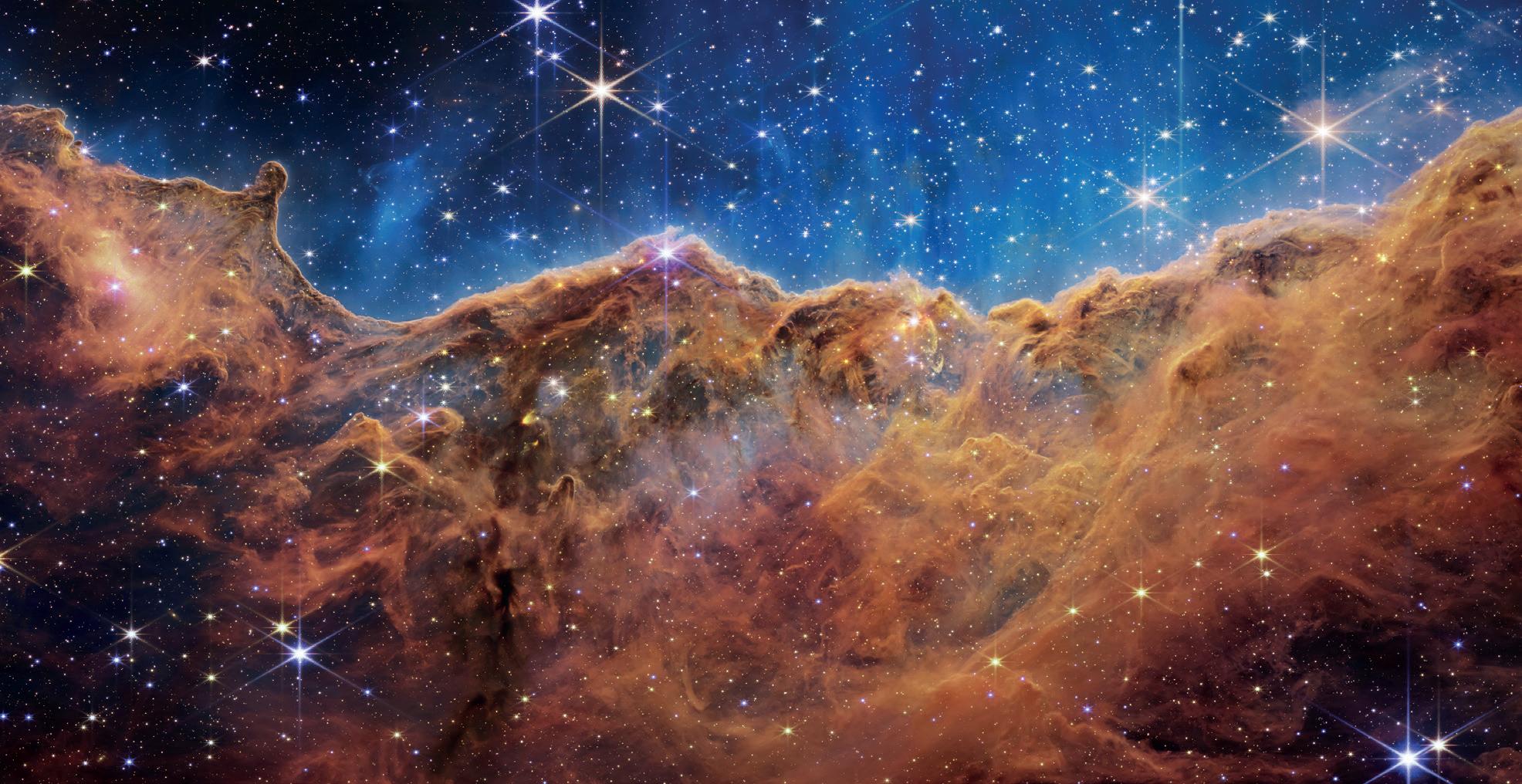
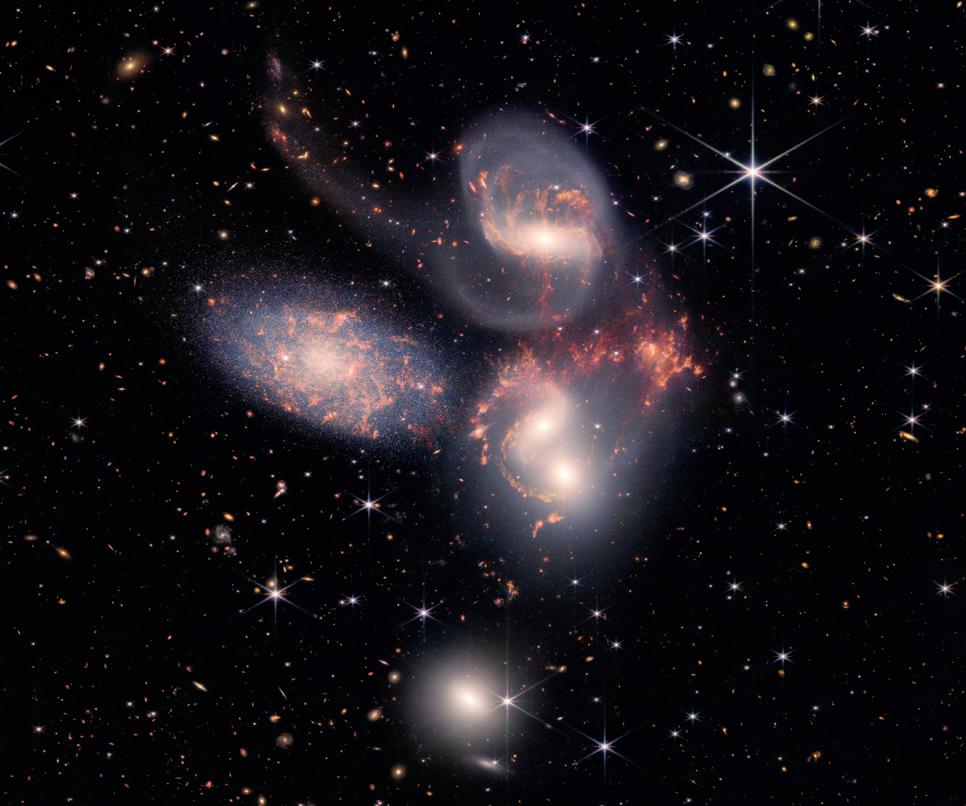
ABOVE: Webb’s view of Stephan’s Quintet, a compact group of galaxies located in the constellation Pegasus, will give scientists new insights into supermassive black holes and how galaxies interact. The image contains over 150 million pixels and is constructed from almost 1,000 separate files. NASA, ESA, CSA, and STScI LEFT: This seemingly three-dimensional image of the Carina Nebula – nicknamed the Cosmic Cliffs – looks like a landscape of glittering mountains and valleys. In reality, it is the edge of a giant star-forming region, buffeted by the blistering ultraviolet radiation and stellar winds emanating from the young stars in the centre of the nebula. The tallest peaks in this image are about 7 light-years high. NASA, ESA, CSA, and STScI

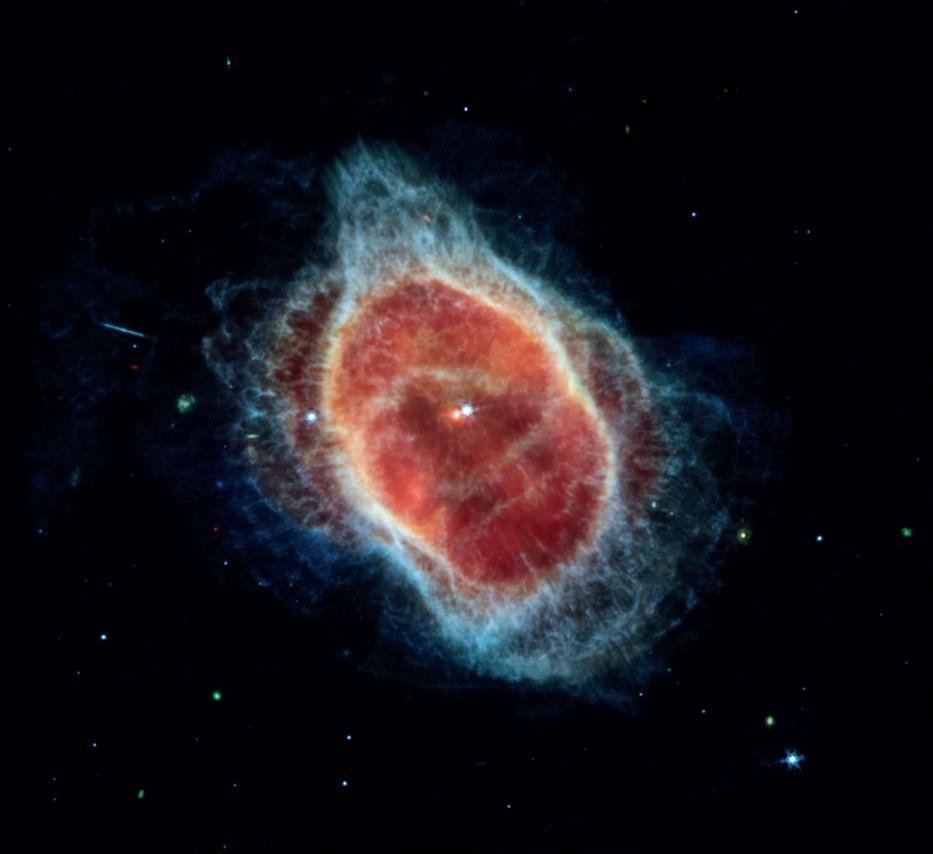

OPPOSITE: This planetary nebula – an expanding cloud of gas that surrounds a dying star – is approximately 2,500 light years away. Known as the Southern Ring Nebula, it is revealed here in all its beauty by both Webb’s Near-Infrared Camera (Top) and its Mid-Infrared Instrument (Below). NASA, ESA, CSA, and STScI ABOVE: Webb’s First Deep Field image, this is galaxy cluster SMACS 0723 as it appeared 4.6 billion years ago. The image is teeming with thousands of galaxies – including the smallest, faintest objects ever observed. The image was captured over 12.5 hours by Webb’s Near-Infrared Camera. NASA, ESA, CSA, and STScI
It’s fifty years since Gene Cernan became the last man to walk on the moon. Richard Hollingham shares a unique conversation with the late NASA astronaut. It covers a career that includes a ‘spacewalk from hell’, a near-death experience at the moon and the final Apollo mission to the lunar surface.

ABOVE: Gene Cernan from 1971 . NASA OPPOSITE: Apollo 17 EVA. NASA Shortly after 05:30 GMT on 14 December 1972, the commander of Apollo 17, Eugene Cernan, prepared to step off the surface of the moon. During this final Apollo mission to the moon, Cernan and his companion, geologist Dr Harrison Schmitt, had set records for the longest time spent on the moon (seventy-five hours in total, twenty-two of those outside), the distance travelled in the lunar rover (35km/22 miles), and the amount of rock they were bringing back to Earth (111kg/244lb). By every metric the expedition was a success.
With the world watching, Cernan knew that his final words spoken on the lunar


surface – just like Neil Armstrong’s first – would go down in history. But he had no idea what he was going to say.
‘I’m more of an ad-lib guy,’ he told me. ‘I tend to put the words together as they come to me. I, honest to God, did not know what I was going to say until we left.’ It is perhaps why the final words spoken on the moon sound so heartfelt. ‘America’s challenge of today has forged man’s destiny of tomorrow,’ said Cernan. ‘As we leave the moon and Taurus-Littrow, we leave as we came, and, God willing, we shall return, with peace and hope for all mankind.’ What saddened Cernan – even angered him at times – was that he never got to see NASA’s plans take shape to return humans to the moon (see page XXX). For the rest of his life, and to this day, Cernan remains the last man on the moon.
The interview that follows was recorded at an event called Spacefest (which very much does what it says on the tin) in Tucson, Arizona, in the summer of 2016. It was one of Cernan’s last interviews. He died, aged eighty-two, a few months later. Both suffering from jet lag, we met in his hotel room at seven in the morning and chatted for almost two hours. I had met Cernan a couple of times before but on this occasion he was more contemplative, happy to talk about the highs and lows of his extraordinary career as an astronaut. Growing up in a small town near Chicago, the son of Czech and Slovak immigrants, Cernan graduated from high school before studying electrical engineering at university. But he had always wanted to fly. Realising his ambition, he qualified as a captain in the US Navy and flew fighter jets off aircraft carriers; he also earned a master’s degree in aeronautical engineering. With some 200 landings on moving ships behind him, he was selected as an astronaut in 1963. Over three spaceflights, spanning six years, Cernan became the third person ever to walk in space, was one of only three astronauts to journey to the moon twice, 1 and was the only astronaut to twice fly a lunar lander. As a member of the crew of Apollo 10 – along with Tom Stafford and John Young – he also holds the record for the fastest re-entry to the Earth’s atmosphere and, therefore, the record for the fastest speed ever attained by humans. In May 1968, they returned home at 39,937km/h (24,816mph). He deserves to be remembered. 2
1 The others were Jim Lovell (Apollo 8 and 13) and John Young (Apollo 10 and 16). 2 I have made only minor grammatical and punctuation edits to Cernan’s words and have sometimes abridged his answers.
For clarity, I have added additional information to some of my questions.
OPPOSITE TOP: The crew of Gemini 9, Thomas Stafford (left) and Eugene Cernan, January 1966. NASA LEFT: Cernan practising with his ‘Buck Rogers backpack’ at the laboratory, ahead of his pioneering Gemini 9 spacewalk. NASA

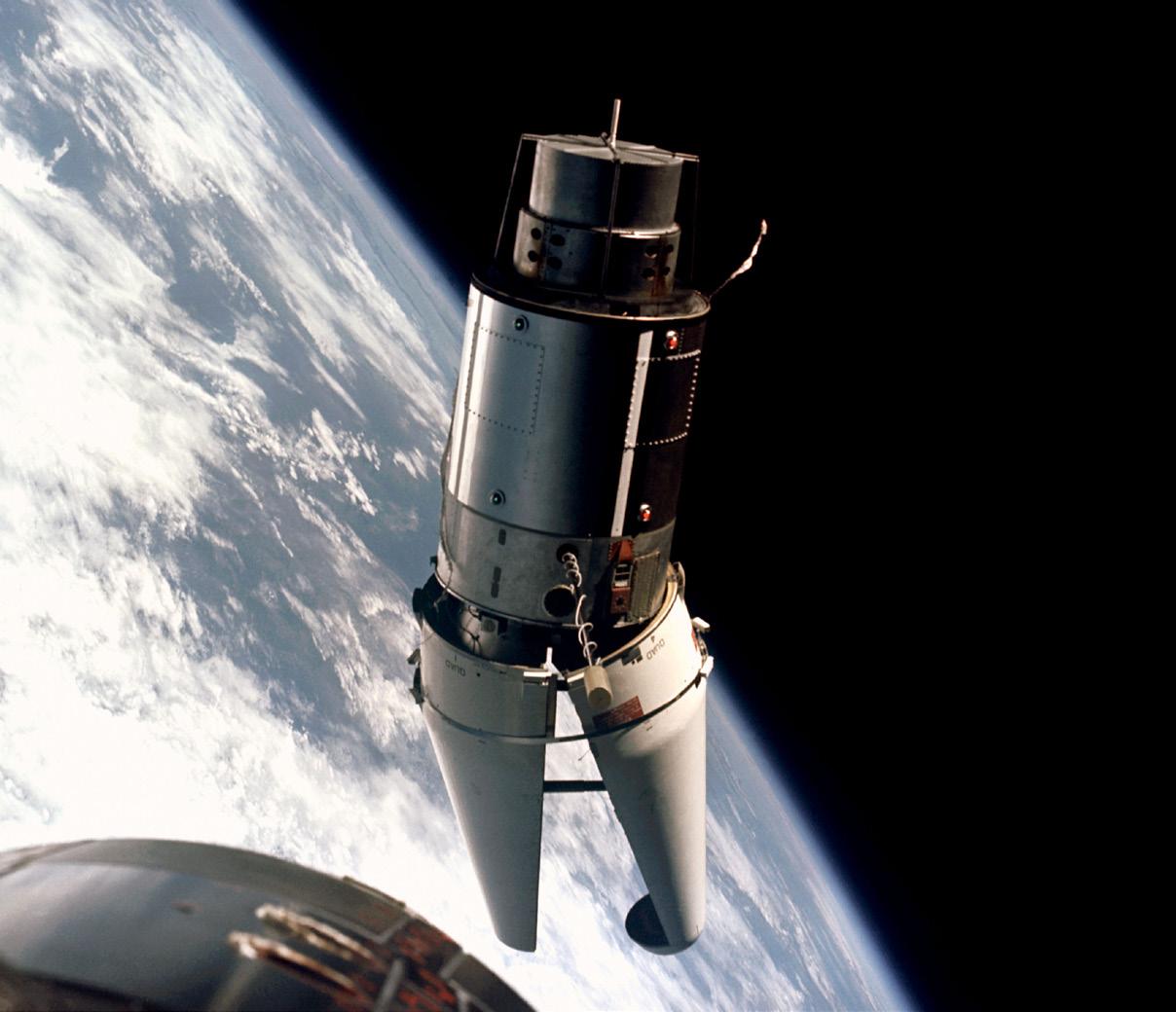
ABOVE: The ‘angry alligator’ – the docking target as seen from the Gemini 9 spacecraft. NASA OPPOSITE: Cernan outside the spacecraft on what was only the second American spacewalk in history. NASA RICHARD:I’d like to start by talking about your first mission in 1966, Gemini 9. Gemini was a two-man spacecraft designed to prove some of the technologies needed to go to the moon. Can you give us a sense of how important the Gemini programme was?
GENE:We didn’t know beans about going to the moon. We had a whole reservoir of things we had to learn. That’s when Gemini came in. Gemini was the bridge, and a very important bridge, that we had to cross successfully to get to Apollo. We needed to learn how to rendezvous, we needed to learn how to spend long durations in space. We needed to learn how to get out of spacecraft and confront the elements of not just zero gravity, but the vacuum of space. All the things that we were going to have to confront and learn how to do to walk on the moon. Did we have some failures in Gemini? Yes. Do you learn from your failures? Hopefully you do.
RICHARD: From the off, your Gemini 9 mission had failures – you and Commander Tom Stafford were due to practise rendezvous and docking manoeuvres with an unmanned spacecraft, the Agena target vehicle, but that plunged into the sea shortly after launch. A replacement docking target then reached orbit but failed to deploy. When you finally launched and reached orbit, you found that you couldn’t dock. GENE: Tom Stafford nicknamed it the angry alligator. The jaws were open, it was held on by a band, and there was a lot of discussion over whether I should get out of the spacecraft, spacewalk and try to cut that band off. A lot of people said it would be damn-near suicide because as soon as you cut the band that thing’s going to snap and where’s it going to go? It’s probably going to hit me somewhere. The decision was made not to do it, which was probably a good decision. And so, we just rendezvoused on that vehicle, which we were going to have to do in Apollo. And then the last day [of the Gemini 9 mission], it was my spacewalk, which was a whole other interesting deal.
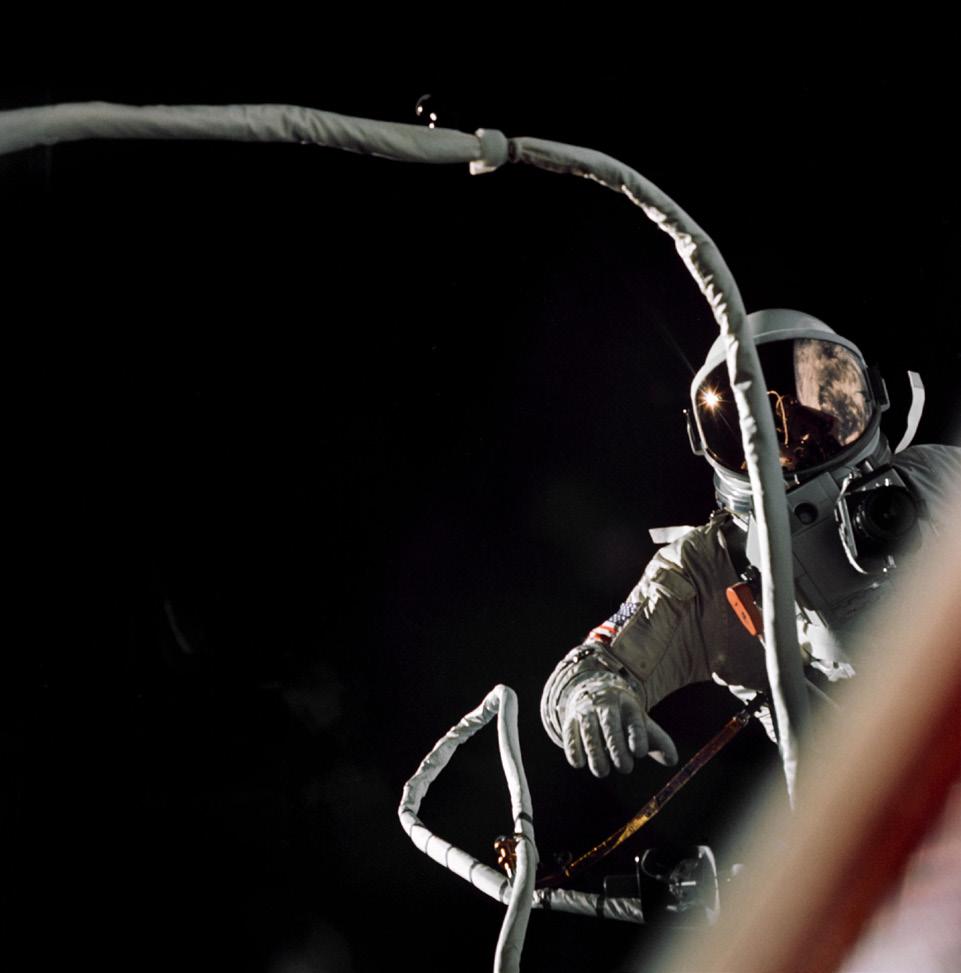
RICHARD: This would be only the second American spacewalk, or extravehicular activity (EVA), and it was hugely ambitious. You had to leave the Gemini capsule, spacewalk around to the rear and attach yourself to a device called the astronaut manoeuvring unit. You’ve called it ‘the spacewalk from hell’.
GENE: You know, as smart as we were, as engineers, we’re in zero gravity and I had no tethers to hold me down. I was standing on a handlebar in zero gravity. You don’t stand in zero gravity. So, I had to basically assemble, as I call it, this Buck Rogers backpack. I was going to fly around out there on a 38m (125ft) tether. I had to turn the fuel valves on but every time I turned a valve in zero gravity, it turned me. So here I am, turning the valve and I’m floating back out there and trying to hold on with one hand. I had to put one foot under the handlebar and one on top just to hold myself on. It was very difficult. I ended up overpowering the environmental control system, my helmet fogged up so I couldn’t see. I also ripped a bit of my suit and I could feel the burning sun come through the thermal layers. It was an interesting spacewalk.
RICHARD: And the astronaut manoeuvring unit was also potentially dangerous.
GENE: I wore chrome steel woven pants. Should have caught that one right away. Why the hell? Well, because this particular rocket pack had hydrogen peroxide rockets in it, which I was going to use to manoeuvre myself around. You fire a rocket, boom, there goes the fire. And someone said, we can’t let him catch on fire. Maybe we’ll make steel pants. You know, there’s so many things we didn’t catch, and I probably should have caught most of them.
RICHARD: You were having so much difficulty that, in the end, Tom Stafford and mission control called off the spacewalk and ordered you back inside. But even squeezing back into the spacecraft was a challenge.
GENE: My heart rate was going 170 beats a minute back there. On the ground the doctors were going bonkers – they’d got an astronaut going around the world with 170 beats a minute. They knew I was in trouble. I’ve always said I didn’t go to the moon not to come home, and I didn’t get out of that Gemini spacecraft not to get back in – as hard as I knew it would be. I was bent like a pretzel, every bone of my body bent one way or another. And it hurt. It hurt. Tom finally pressurised the spacecraft then my suit went down, and I could take a breath. He said I was so solid red, I looked like a turnip. When I got my helmet off, he took the water nozzle and he just squirted me with it.
There’re so many things we missed on Gemini 9 that we could have thought of ahead of time. The other side of that coin is that the more successful you are, the more complacent you get. I always looked at my EVA as a failure, I let the guys down. In retrospect, over time, we probably learned more because of the problems I had than we would have if everything had gone successfully.
RICHARD: What would have happened if you couldn’t get back into the spacecraft … was there a plan?
GENE: Yeah, there was. But we didn’t talk about it much. Tom would have had no choice. He would have had to come home without me. He would have disconnected the umbilical and I’d still be floating up there somewhere. It sounds terrible, but you know, supposing we couldn’t get guys off the surface of the moon? There was no rescue ship. We had to accept the fact that there was some risk.
RICHARD: Your second mission was Apollo 10 in May 1969, billed by the media LEFT: The Earth rising above the lunar horizon, photographed from the Apollo 10 Lunar Module. NASA BELOW: The Launch Control Center at the Kennedy Space Center, May 1969. NASA
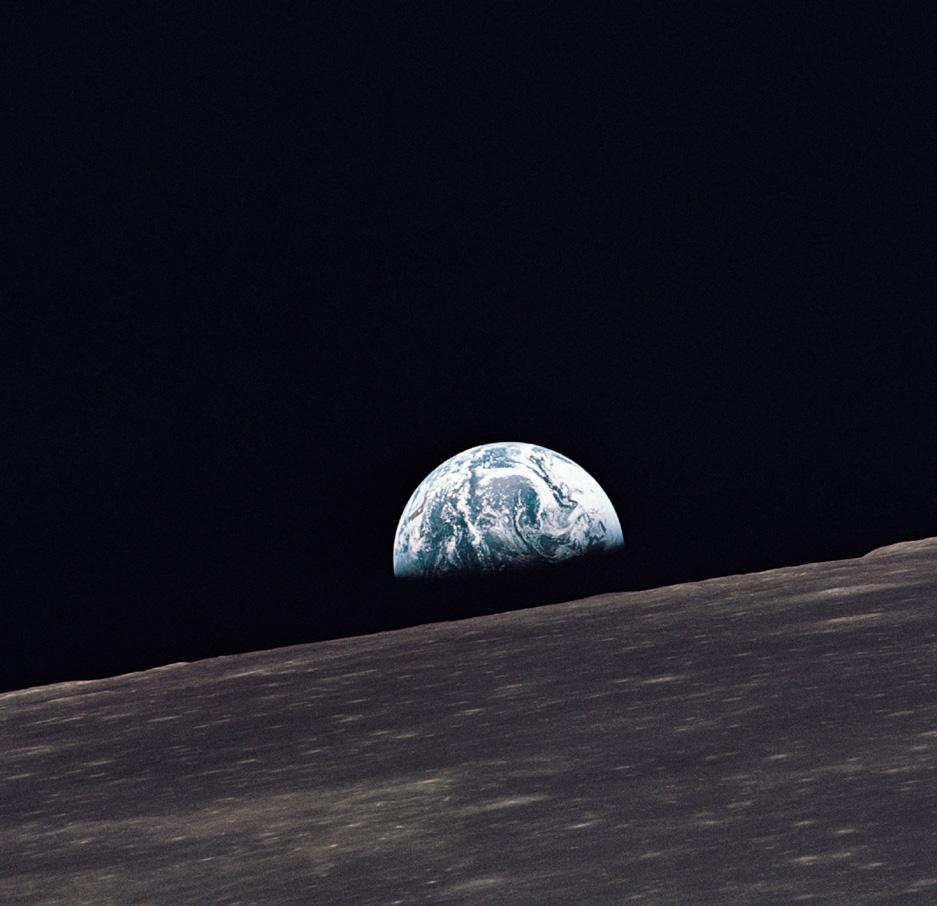
as the ‘dress rehearsal’ for the Apollo 11 landing later in the year. Three of you flew to the moon – John Young remained in the command module as you and Tom Stafford took the lunar lander to within just 14km (8.7 miles) of the lunar surface. But it was during your return to the command module that things went wrong.
GENE: The mission was going great. But as many times as we practised what we were doing, human error can always come in. I flipped the switch over here on the left. Tom knew which switch had to be changed [for the manoeuvre] and he takes it and flips it over the other direction. And the spacecraft spun out of control. I saw the lunar horizon go by in different directions eight times in fifteen seconds. Is that scary? Yeah, if you get time to be scared, but I didn’t have time to be scared. Tom finally was able to take over manually. And, God bless his soul, he literally saved my life because they told us afterwards had we gone around once or twice more, two things would have happened: we would have gone into what they called gimbal lock, where all our navigation equipment froze up and you’re really in trouble then. Or we would have taken enough


Harrison Schmitt standing next to a lunar boulder during the Apollo 17 mission, 13 December 1972. NASA/Eugene Cernan
energy out of our orbit that we would have slowly drifted down to the surface. So, you’ve got to be careful that you don’t get too overconfident.
RICHARD: Let’s talk then about Apollo 17 – the culmination of the Apollo programme. You and Harrison Schmitt drove some 35km (22 miles) across the lunar surface, you got so much science done and you left the final footstep. You must be proud? GENE: I was an underdog, the guy that didn’t go to test pilot school. I needed that flight to prove that I was good enough. I was willing to literally turn down an opportunity to walk on the moon [during an earlier opportunity] for maybe a chance to command Apollo 17. And that’s what I felt when I stepped on the moon. It wasn’t the steps that counted. It was the fact that I proved to myself that I was good enough to get that far.

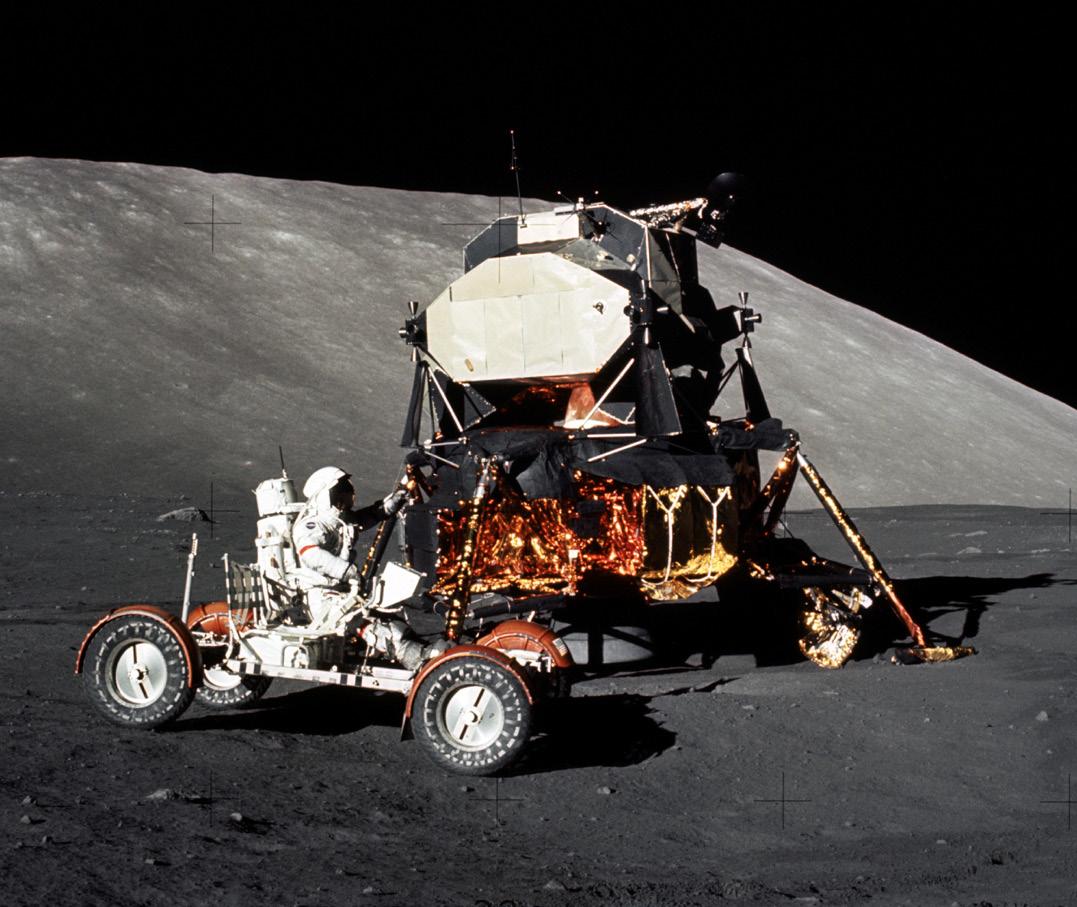
OPPOSITE: The Apollo 17 Lunar Roving Vehicle on the surface of the moon. NASA ABOVE: Cernan driving the Moon buggy with the Lunar Module in the background. NASA/ Harrison Schmitt
I was on a high the whole time. Everything seemed to work pretty well because every flight we had built upon the previous flight, built upon its successes and built upon the failures. And when we got to Apollo 17, I think we were really prepared. And from a scientific point of view, I took a scientist and they say this is the best science flight we’ve ever had. Just going to the moon and picking up a rock was not going to be good enough. We had to accomplish and come back with some answers to questions we didn’t even know that we were smart enough to ask.
RICHARD: You’re a firm advocate for a return to the moon. What can people – astronauts – do on the moon that robots can’t?
GENE: The robot is only as smart as we make it before we send it. This brain right here is the most complex computer in the world. It’s human courage, human culture,

human ability to think, to understand what discovery is. We’re curious, you can’t make a robot curious. And curiosity is the essence of human existence. What’s on the other side of that hill? What’s across the river? Now, a robot may not care, and it may not ask the question, but you do. When have we had a ticker-tape parade for a robot?
RICHARD: You’ve spent most of the latter part of your career taking part in education programmes, talking about your career, and you even starred in a documentary film about you, Last Man on the Moon, which was met with glowing reviews around the world.
GENE: Young kids have to see that these guys who went to the moon didn’t come out of the sky in silver capes. You know, they put on their pants one leg at a time and had a family, they had kids. They made mistakes. There was a message I felt almost responsible to leave with these kids. If I can do it, why can’t they? And if I can get them to try, then maybe they’ll realise how good they can be.
OPPOSITE:The crew of Apollo 17 captured the famous Blue Marble picture of the Earth, depicting Africa at its centre. NASA BELOW: Apollo 17 is still producing useful science. In 2019, NASA scientists opened an untouched rock and soil sample from the mission to analyse it with technologies not available in 1972. NASA/James Blair
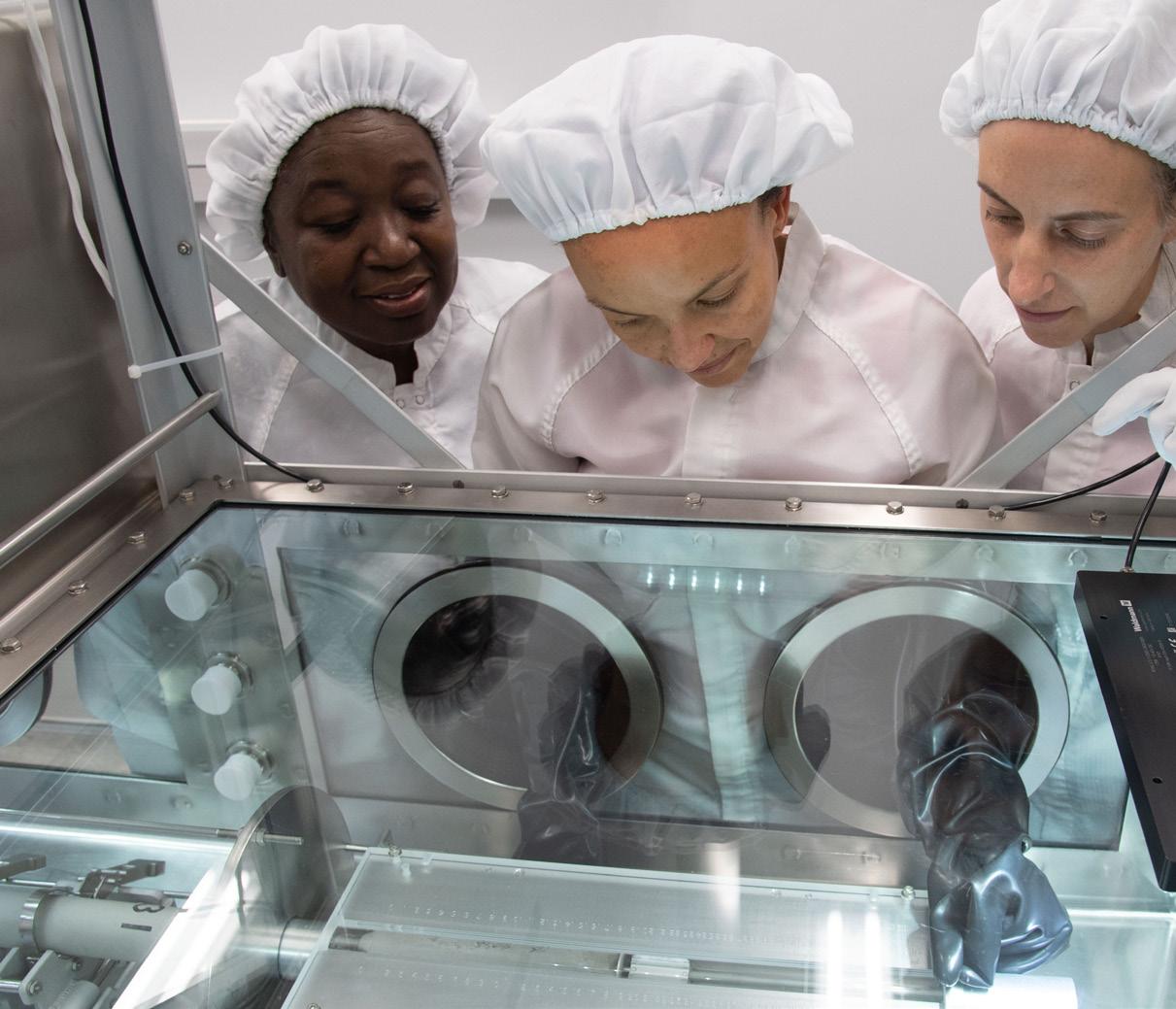

THE SONG OF THE UNIVERSE
From the moon to MeerKATs, Sarah Wild explores the challenge of building the world’s largest radio telescope.
If you really want to get away from it all, then the far side of the moon is hard to beat. Standing on the edge of a rugged crater, you would be almost completely shielded from the cacophony generated by humanity on Earth. It’s a perfect location to listen to the radio waves whispered by celestial objects. Nearly all things you can see in the cosmos – and many you can’t – emit radio waves. Some, like exploding stars, scream their presence into the void, while others, like the first galaxies that formed after the Big Bang, only murmur their secrets to those searching for them. Radio telescopes detect these weak signals and piece them together to listen to the song of the universe. But even the loudest astronomical object is only a slight mumble when pitted
PREVIOUS PAGE: The SKA will have telescopes in both South Africa and Australia, joined together to act as one giant instrument. SKA Observatory RIGHT: Prototype antennas for the SKA low-frequency telescope in Australia. Michale Goh/ICRAR-Curtin

against a mobile phone or a nearby car, which is why the far side of the moon is so ideal. Unfortunately, shipping thousands of tonnes of radio telescope to the moon is not particularly practical, to say nothing of the cost and carbon footprint. So when the team behind the Square Kilometre Array (SKA) started hunting for a site to host the world’s largest radio telescope they looked instead to some of the quietest corners of Earth, places where humans were few and economic activity limited. They found them in the dry plains of South Africa and Australia. Despite being more than 10,000km (6,200 miles) apart, the two locations will each host a piece of the world’s largest radio telescope. When complete, the SKA will comprise about 2,000 giant dishes on the African continent and up to a million Christmas tree-like antennas in Australia, all working together to make up – you guessed it – 1km2 (0.4 square miles) of collecting area. In these remote places in the southern hemisphere, with only panoramic skies for company, the SKA will be able to answer some of astronomy’s major open, and most fundamental, questions: Are we alone? How are galaxies formed? And what happened just after the Big Bang? After almost three decades of planning, the SKA Observatory has started awarding tenders for construction of the €1.9 billion first phase of the project. In 2019, seven founding nations – Australia, China, Italy, the Netherlands, Portugal, South Africa and the UK – established the observatory, and recently Switzerland joined as the eighth member. Numerous other countries, such as Germany and France, are participating through their scientific organisations. Meanwhile, providing a tantalising preview of SKA’s potential, in South Africa’s Karoo hinterland, sixty-four dishes three storeys high – collectively known as the MeerKAT telescope – are already listening to the secret sounds of the universe.

COMPARE THE MEERKAT
The name MeerKAT sounds like a clever marketing ploy, but it came about more by accident than design. If you ask South African officials about the origins of MeerKAT, they will point to the small endemic mongoose characteristically observed standing on its back legs (in order to see further) in the dusty plains of southern Africa. But once upon a time, when South Africa was trying to prove its willingness and ability to host the giant SKA, it built a modest seven-dish instrument, the Karoo Array Telescope (KAT-7 for short). When the designers went to the government to ask for more money, they said it was for ‘meer KAT’, which is ‘more KAT’ in the local Afrikaans language.
Today, MeerKAT dominates the arid plains of the Karoo. Like sunflowers following the sun, its sixty-four giant metal antennas track astronomical objects and listen to the radio waves they emit. They resemble satellite TV receivers on steroids: giant white dishes, with a nose. The radio signals hit the dish, bounce off its surface to collect in the nose, and then bounce back to a receiver in the centre of the dish.
All of these dishes, which sprawl over 8km (5 miles), are connected and act as one giant telescope – just like the SKA will do. Eventually, these dishes will form the heart of the first phase of the SKA in South Africa. In total, there will be 197 dishes, many of them radiating out from the core in spiral arms and extending over about 150km (93 miles). Later phases will see more dishes in South Africa, as well as in eight partner African countries. Until then South Africa’s MeerKAT is busy day and night collecting radio signals from space.
Unlike optical astronomy which focuses on the relatively tiny visible light range, radio telescopes collect signals from a larger part of the electromagnetic spectrum. MeerKAT, for example, focuses on wavelengths between 3 and 30cm (1–12 inches), while visible light occupies a tiny – literally – sliver of the spectrum with wavelengths between 400 and 700 nanometres. In South Africa, SKA will collect mid-frequency signals (where wavelengths are in the centimetre range), while in Australia, its antennas will concentrate on lower radio frequencies (where we are talking about metre wavelengths). [Would be good to have a graphic of the electromagnetic spectrum here or a page ref to the JWST feature that might also have one]
By collecting and collating data from different radio frequencies, astronomers can map out the dark recesses beyond Earth, like blind cartographers listening to the sounds of the cosmos. Properly interpreted, the data they gather will allow them to see into the past in a way never dreamed of by early optical astronomers, and in ways previous generations of radio astronomers could not have hoped for. OPPOSITE: An aerial photograph of MeerKAT during its construction in 2017. South African Radio Astronomy Observatory (SARAO) BELOW: The MeerKAT site as seen from the air in 2018. South African Radio Astronomy Observatory (SARAO)

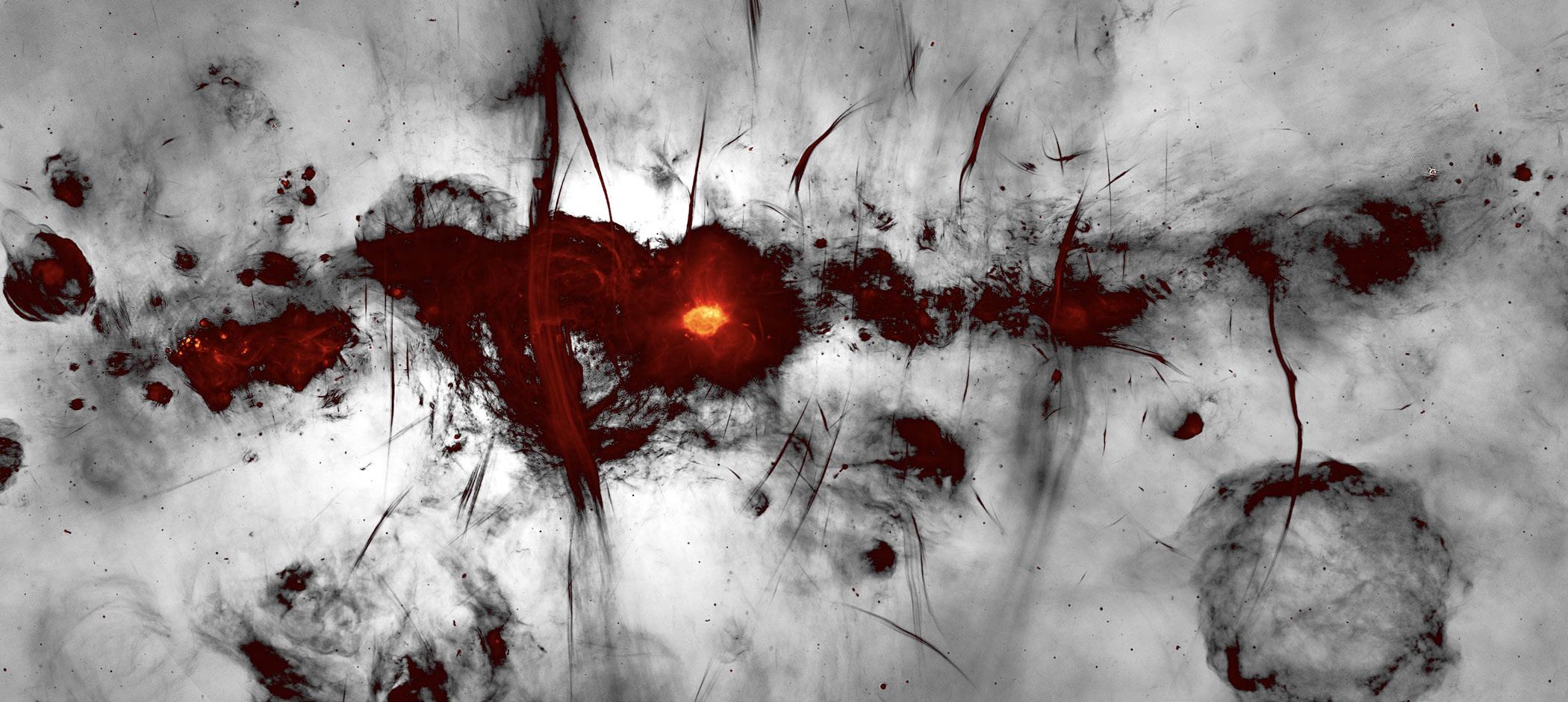
The new MeerKAT image of the centre of the Milky Way, nicknamed the Eye of Sauron. Ian Heywood/South African Radio Astronomy Observatory (SARAO)
EYE OF SAURON
The MeerKAT is already giving us a new perspective on our galactic neighbourhood. In early 2022, an international team published the most detailed image of the centre of our galaxy, the Milky Way. And at its heart glows our supermassive black hole, emitting mysterious radio threads up to 150 light-years long, surrounded by the remnants of exploded stars and regions where new stars are forming. It’s not possible to see such detail with your eyes, so astronomers and data scientists created an image of the black hole from the radio signals.
‘When I show this image to people who might be new to radio astronomy, or otherwise unfamiliar with it, I always try to emphasise that radio imaging hasn’t always been this way and what a leap forward MeerKAT really is in terms of its capabilities,’ lead author Ian Heywood, an astronomer at Oxford University, said when the paper was published.
While a giant leap for radio astronomy and cosmology, the image is a bit disconcerting. It resembles the Eye of Sauron, from The Lord of the Rings, with angry flashes of red and grey, and a burning yellow black hole.
It is based on observations taken over about 200 hours during the telescope’s commissioning phase, and the MeerKAT team has made the data available to all astronomers. ‘The work we’re doing with MeerKAT will eventually inform the science we’re going to do with the SKA,’ says Erwin de Blok, an astronomer at the Netherlands Institute of Radio Astronomy (ASTRON) and the principal investigator of a large MeerKAT survey looking at galaxies. ‘The nice thing is that, with MeerKAT, we will solve some of the problems that we currently have, but we will also probably just create new questions for the SKA.’
The SKA team has set itself some lofty big-picture science aspirations, dreamed up by thousands of astronomers from around the world over the course of decades. First came the science questions – such as what the universe looked like just after the Big Bang, as energy exploded through the void and coalesced into galaxies – and then scientists asked what kind of instrument they would need to be able to investigate them. The short answer: they would need a big one.
Such a large telescope, with its dishes and antennas so far apart, allows a sensitivity not possible with current instruments. In fact, the full SKA will be fifty times more sensitive, and be able to survey the sky 10,000 times faster, than any radio telescope array previously built. With such capabilities, it will be able to explore how magnetic fields crisscross the cosmos, holding galaxies together like butterflies in invisible cocoons, and how new stars and planets form. It may even be able to answer that age-old question which scientists have recently started to take much more seriously: are we alone in the universe? But what is perhaps even more tantalising is the prospect of the discoveries we are not expecting.
Sarah Pearce, Director of the SKA telescope project in Australia, is excited at the thought of what such a large low-frequency array will detect, while listening to wavelengths that span metres. ‘Low-frequency radio telescopes are not a new invention, but there are fewer of them around the world,’ she explains. ‘We will absolutely see phenomena that we wouldn’t have seen otherwise.’
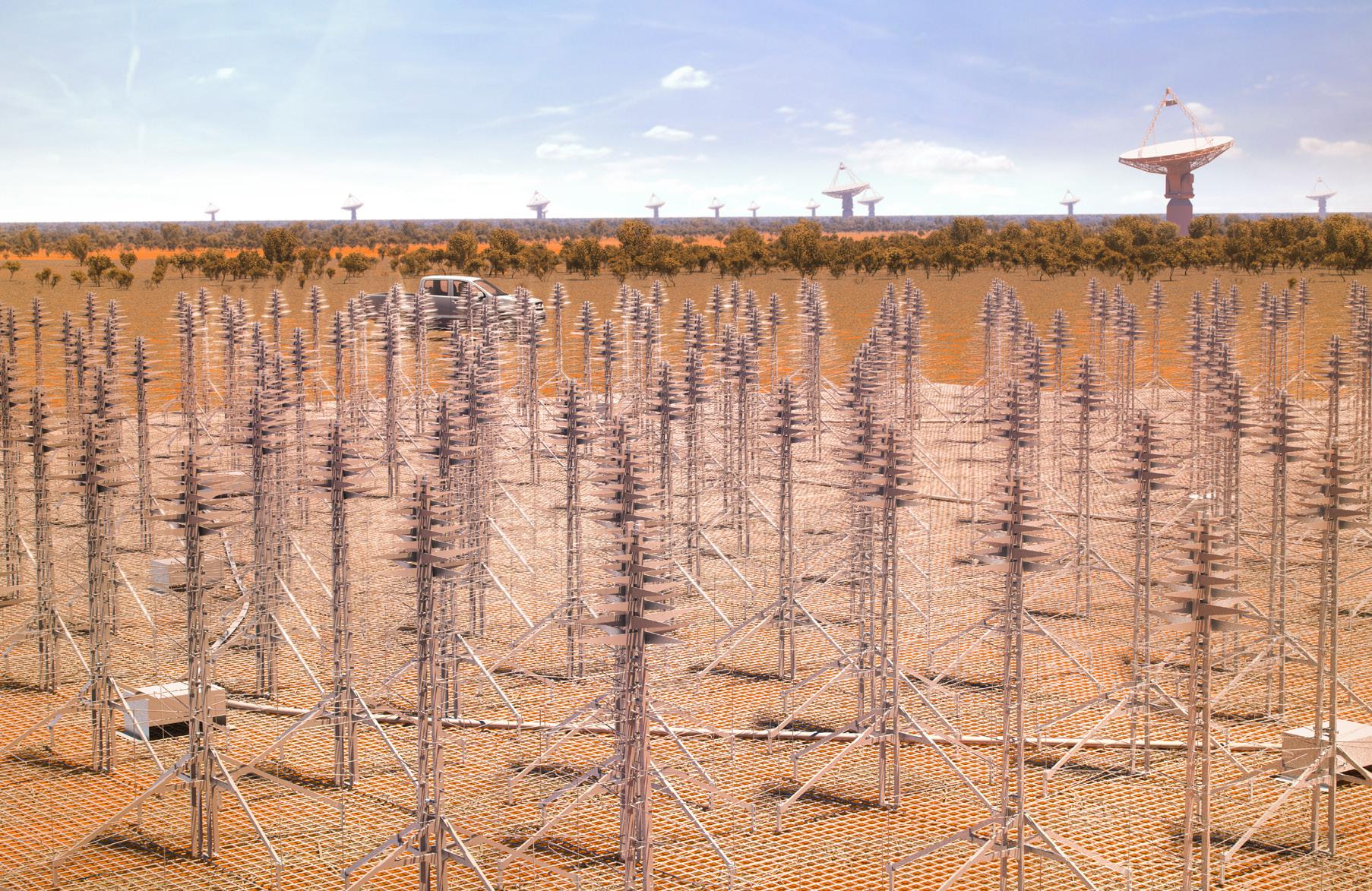
ERRATIC POLKA DOTS
In the next few years, the red sands and patchy khaki shrubs of western Australia will sprout thousands of 2m (6ft) high antennas. Looking like a cross between a television aerial and a wire Christmas tree, these antennas will detect wavelengths between 1 and 6 metres (3–20ft) – significantly longer than those of the mid-frequency dishes in South Africa’s dry and dusty Karoo. In total, there will be more than 130,000 antennas, divided into arrays of 256. These array stations will spot the Australian landscape like erratic polka dots, although not so haphazardly to the radio engineers and astronomers who have spent years of their lives deciding exactly where to place them. By combining the data collected by these signal-receivers, astronomers will create the most comprehensive low-frequency map of the southern skies to date. The first batch of antennas has been ordered – enough for six arrays of 256 – and Pearce expects that the team will start deploying them in the next couple of years. ‘We have to deploy them in small arrays,’ she explains. ‘We need to make sure that we don’t need to change anything because changing something on every antenna when you have thousands, while not impossible, will be very difficult.’ The low-frequency array will follow some of the same science as its large-dish companion in South Africa, such as mapping galaxies and tracking their evolution, and searching for highly magnetised rotating neutron stars, called pulsars, that emit pulses of radiation. But Pearce anticipates that the Australian SKA will truly come into its own when studying the early universe. Australia’s SKA telescope will consist of arrays of Christmas tree-like antennas, which pick up faint signals from the cosmos. SKA Observatory
IT ALL STARTED WITH …
In the first moments after the Big Bang, our universe was so hot that it was not even matter, but rapidly expanding pure energy. As it expanded from the scene of that cataclysmic explosion, the universe cooled, creating protons, electrons and ultimately the simplest atom, hydrogen. These foundational building blocks attracted more matter, and formed the first stars, whose light filled the swirling primordial gas cloud of the early universe. This is known as the Epoch of Reionisation. This epoch is a source of fascination for astronomers. It is when the first stars and galaxies lit up, illuminating our universe. Over time, this radio light from primordial gas – once energetic and vivid – has relaxed, its wavelengths lengthening and shifting into lazier radio waves as it traverses the billions of years and miles that separate us from its origin. The SKA’s low-frequency array, under the clear Australian skies and far from the intrusion of towns and cities, will be able to detect primordial hydrogen gas and image this so-called ‘Cosmic Dawn’.
It says something for the global ambition of the project that the SKA headquarters is on the other side of the world at the iconic Jodrell Bank Observatory in England. First used in 1945, Jodrell Bank hosts numerous telescopes, such as the massive Lovell Telescope (see overleaf). It is the hub of the project, overseeing what happens at the remote sites in Australia and South Africa.
SPACE PIONEER
The world-famous Jodrell Bank telescope was conceived by Bernard Lovell, a pioneer of radio astronomy. Lovell was born in Bristol in 1913 and studied physics at the universities of Bristol and Manchester until the outbreak of the Second World War. During the war he helped develop radar systems for aircraft and flew on many high-altitude test missions. It was during air raids that he developed several of his scientific ideas.
After the war Lovell acquired a small radar unit to pursue his research into cosmic rays. He was given permission to set up his equipment at Jodrell Bank, in Cheshire, and eventually got the funds to build the Mark I

telescope, then the world’s largest steerable radio telescope. Since renamed the Lovell Telescope, it remains an impressive feat of engineering and still uses gears from battleship gun turrets to tilt its 76m (250ft) wide dish.
Sir Bernard’s scientific discoveries include the investigation of meteor showers, cosmic rays and quasars. These extremely distant astronomical objects can emit enormous amounts of energy, including strong radio signals X-rays and gamma rays.
In October 1957, just months after it was completed, the Mark I telescope proved to be the only way of tracking the first satellite, Sputnik 1. It also played a vital role as an ‘early warning’ radar to protect the UK against a surprise nuclear missile attack. Later, the telescope was used to discover gravitational lensing, which is when spacetime warps around massive objects.
Lovell was knighted in 1961 for his contributions to the development of radio astronomy. In 2019, UNESCO declared Jodrell Bank Observatory a World Heritage Site, saying its ‘exceptional technological ensemble illustrates the transition from traditional optical astronomy to radio astronomy (1940s to 1960s), which led to radical changes in the understanding of the universe’.
The groundbreaking Jodrell Bank telescope in Cheshire, England. Nigel Wilkins/Alamy Stock Photo






